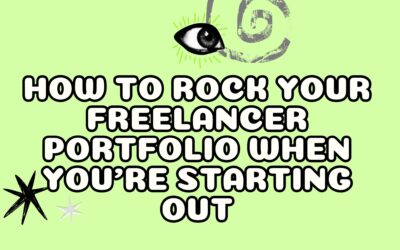More than half of the world’s population uses social media today. That translates to tons of opportunities to connect with different people, including your target audience, helping you grow your freelance business. In this case, an effective social media strategy can help you expand your network and get lucrative high-paying clients.
Instead of shooting in the dark and hoping that you hit the mark, back your social media strategy with tips and data.
Let’s learn which social media platforms are the best for you and how to capitalize on them.
Which social media platform(s) should you focus on?
Despite popular opinion, freelancers don’t have a lot of free time.
So, you might want to pour your efforts into those platforms that bring in the best results.
Whether you’re a graphic designer or a content writer, the best social media platform for you depends on two factors: (i) your goal and (ii) your target audience.
Is your goal to be a part of communities or generate leads? Is your ideal client a health coach or the CTO of a startup?
As a general rule of thumb, you need to be present where your ideal clients are hanging out. You can make any platform work for you if you can get in front of your target audience.
Before we dive in: Download your free list of handy LinkedIn prompts so you don’t have to stare at a blank page anymore!
To make it a little easier for you to choose, here are some quick pros and cons of each platform.
With 2.96 billion monthly active users, here are some pros and cons for Facebook:
Pros
- You can be a part of multiple groups and communities to create connections with peers and your target clients.
- It’s easy to get your account or page set up on the platform.
- The platform supports multiple content types like images, text, and videos.
Cons
- Facebook’s engagement rate is decreasing by the day with users moving away to different platforms.
- Organic reach on Facebook is difficult as the platform wants you to invest in ads.
Bottom line: You can use Facebook to become part of communities of your peers to support them and get support when you need it. You can also find groups where your ideal clients posts about jobs.
With over 1 billion monthly active users, here are some pros and cons for Instagram:
Pros
- It’s a highly visual platform so you can feature your work and showcase your brand personality. This works especially great if you offer a service that needs visual representation, such as graphic designing, video production, and more.
- You can find like-minded users or businesses by searching relevant hashtags.
- You can drive engagement with different tools such as polls and contests
Cons
- If you offer a service like writing, your target audience might not be reachable on Instagram (unless you offer writing for an audience who’s active on the platform such as coaches).
- You need to put effort and time into creating visually appealing images.
- The captions have a text limit, so if you are looking to create more text content, it might not be the ideal platform.
Bottom line: Instagram can serve as your portfolio if your services are visually-led or if you’re specifically offering Instagram marketing, carousel creation, and social media copy. If you provide a highly technical service, Instagram might not be the right place to attract clients.
With over 368 million monthly active users, here are some pros and cons for Twitter:
Pros
- Your tweets can reach a broader audience with Twitter’s retweeting feature.
- It has a robust search tool so you can get in touch with the right kind of people.
- You can follow relevant people in your niche to get all the latest information.
- You can engage with people on an informal level and create meaningful connections.
Cons
- Your tweets are restricted by Twitter’s 280-character limit (unless you pay Elon for the privilege of 4,000)
- The organic reach is limited and you’ll have to post multiple tweets at the right time, otherwise people might miss out on your message.
Bottom line: Twitter is one of the best platforms for freelancers to grow their businesses, attract clients, and create connections with peers. The platform has limited cons which can be easily dealt with.
With over 310 million monthly active users, here are some pros and cons for LinkedIn:
Pros
- Most decision-makers and recruiters are active on LinkedIn, which makes it ideal for cold outreach and getting clients.
- Like Facebook, you can be a part of many relevant communities.
- Linkedin allows you to create longer posts, giving you the space to communicate your message clearly.
- Organic reach is high.
Cons
- Fewer users than the other social media platforms.
- You need to invest significant time, especially at the start.
Bottom line: LinkedIn is one of the best platforms when it comes to networking with professionals and business owners. While the platform has fewer active users, it’s growing by the day. This also gives you high organic growth.
TikTok
With over 1 billion monthly active users, here are some pros and cons for TikTok
Pros
- The video-focused layout makes it attractive for many freelancers and businesses.
- Your audience can engage with you in different ways like using your audio and stitching your videos in theirs.
- Organic reach is high.
Cons
- The audience is skewed toward younger people.
- You’ll have to deal with content format limitations.
Bottom line: Contrary to popular opinion, TikTok can be a good source of business growth. More people are recognizing the powerful algorithm of TikTok and jumping on the platform for exposure. You can just find your target clients on TikTok.
How to set up your social profiles
Whether you choose LinkedIn or Twitter to flog your wares, your social profile should convey what you do, who you help, and how you’re different from others.
Here are four points, along with examples, that will help you create a stellar social media profile that attracts clients and increases conversions.
1. Have a clear profile picture and cover photo
The first thing anyone notices on your profile is your profile pic and cover photos, so make sure the profile picture you use is a recent one (and includes your face, if you’re not too shy).
A lot of freelancers don’t use their cover photos properly. The cover photo gives you the place to talk about the clients you’ve worked with or highlight your USP. Anything that might attract your target audience, goes in the cover photo.
Here’s how Matt Barker cleverly talks about why you should follow/hire him in his cover photo.
2. Showcase your expertise in the title and bio
If people are messaging you asking what you do, it’s a sign that you need to work on your title and bio. See how I’ve specified in my Twitter bio my niche and the publications I’ve written for.
3. Create a similar username for all your social profiles.
Create a simple and short username. Keep it consistent for all platforms so that if someone needs to search for you on a different platform, they can easily do so.
4. Add a link to your website or portfolio
This gives you a chance to showcase your best work, and prospects can easily go through it before they contact you for work. Here’s how Erin Brenner, an editor, cleverly puts in a link, “Let’s finish it,” that takes you to her website, where you can hire her as an editor.
How to create a social media strategy
Now that you know how to set up your profile, let’s see what you can post and do on each of these platforms.
1. Facebook
If you’re just starting with your Facebook page, you can invite your family and friends to like the page to get initial traction. Start engaging with other pages, groups, and users relevant to your niche along with posting content regularly. This could mean liking, commenting, and sharing their posts.
How does this help?
When you leave insightful comments on others’ posts, you can broaden your audience, and they might visit your page and end up following you.
Make sure you niche down on the topics you want to post regularly about and create a social media calendar with the same.
If you’re a freelance writer, you can share links to your articles and add a compelling paragraph or two to the post. This allows you to showcase your work, and you might get more visitors to these articles.
2. Instagram
Instagram can be the perfect place to showcase your work portfolio, especially if you’re into the visual field like graphic design or animation.
When it comes to the type of content to post, it depends on your goal:
- For lead generation, share content around the kind of work you do, the clients you’ve worked with, testimonials, and your best work.
- For community building, share some personal experiences along the way, and tips and tricks for your fellow freelancers.
Here’s an example by Madison and Haley who run a freelance service together and make carousel posts for their audience that get thousands of likes.
While it was recently clarified that using tons of hashtags doesn’t improve engagement, you can still use hashtags to find and connect with your audience.
Apart from pictures, you can include reels and Stories in your content strategy. These formats are becoming popular and they help you build a personal connection with your audience.
Take a look at how Fia, a freelance designer, turns her Instagram profile into nothing short of an aesthetic portfolio.
3. Twitter
The character limit on Twitter can be an advantage for freelancers who are short on time but still want to increase their engagement. You can quickly read people’s tweets, engage with them, or retweet something.
Make sure you follow your ideal clients and interact with their tweets. The goal here is to build genuine connections. Even if they don’t require your services currently, they might contact you in the future or refer you to others.
Here’s how Nathan made his first $100 as a freelance writer on Twitter.
You can follow Twitter accounts that post freelance jobs in your niche or participate in discussions that might land you a lead.
Pro-tip: Ask questions that start conversations in your comment section. This can not only promote engagement, but you can also build valuable connections.
4. LinkedIn
Many people prefer LinkedIn to search for freelancers and hire them – a reason why you should have a complete profile with your work experience, skills, and reviews.
You also need to add relevant keywords in your headline and “About” section to appear in search results when a client searches for a freelancer in your niche.
While creating a content strategy for LinkedIn, include relevant topics to your niche. For example, talking about general writing tips may increase engagement if you’re a freelance writer. But if you’re looking to get conversions, include content about your experience as a writer, tips and strategies for the niche, and so on.
If you’re still confused about what to post, here are some prompts to help you out.
Look at how Dina Calakovic talks about LinkedIn writing in most posts as she helps people build their personal brands on LinkedIn.
5. TikTok
TikTok might not seem like an ideal business platform on first thought but many freelancers and business owners use it to reach a wide audience and create a mix of fun and informational videos.
Experiment with different tones and content lengths as the platform allows you to post up to 10-minute videos. TikTok also has a lot of different sound effects and filters that make your videos trendy and engaging. You can adopt the trend as per your niche.
Some TikTokers create anticipation in their videos by using pauses, different storytelling techniques, and unique sounds. You can follow users like Madeline Argy and Elyse Myers to learn how to create videos and content that hit the mark.
What to post on social media: Social media best practices for freelancers
Here are some best practices to make your social media strategy more powerful and effective.
1. Create content around the latest developments and trends in your niche
For example, on LinkedIn, you can find a section on LinkedIn news where recent news bits are published. You can also see the number of readers interested in a piece of particular news. Creating a post around that can help you get featured and garner more engagement.
2. Experiment with different content formats.
A while ago, all-text posts were the norm. But today, Instagram is promoting reels, and on LinkedIn, you might see many posts with pictures. You can take it a step ahead and repurpose content in different formats. For example, if one of your posts got traction on LinkedIn a while back, turn that into an Instagram carousel.
3. Find the right time to post and stick to it.
This helps your information reach more people, and when you consistently show up at a similar time, people take note of that and even stay active to not miss out on your posts.
Experiment with different times to understand what works best for you and your audience.
4. Observe and learn
You can learn as much from observing fellow freelancers’ social media posts as from experimenting with different strategies. You can learn a lot by looking at the type of content they are posting, the various keywords they use on their profiles, and the content formats that work for them.
5. Start conversations
Even if your goal is to get leads, interacting with your followers is essential every now and then. You can either tweet a question or, at the end of your LinkedIn post, ask a follow-up question in relation to the post content. That way, you build a rapport with your fellow freelancers and these connections may bring you valuable leads in the future.
Pro-tip: If your goal is to generate leads for your business, posting tips on freelancing might not help you reach that goal. Remember, post what your audience would like to read.
Ready to build your social media game plan?
With these strategies, you can give your social media game a clear direction and reach your goal of getting more (or better) clients, building a professional network, and gaining authority.
While at it, have fun and experiment with different things. After all, nothing is set in stone when it comes to social media. Don’t forget to nurture the relationships you build on social media and help fellow freelancers when needed.
To kickstart your social media posts, get your free pack of LinkedIn prompts here. Refer to the sheet when you’re short on ideas and understand what type of posts attract your ideal clients.






0 Comments